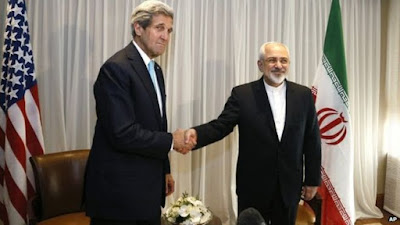 |
| U.S. Navy RQ-4 drone, tracking and video of shootdown |
Following the shootdown of a U.S. Navy RQ-4 Global Hawk unmanned reconnaissance aircraft over the Gulf of Oman on June 20 by air defense units of Iran's Islamic Revolutionary Guard Corps (IRGC), President Trump ordered - and cancelled - retaliatory missile strikes on Iranian targets.
Although the Iranians claim that the aircraft had violated Iranian airspace, video footage taken from another surveillance aircraft (probably a U.S. Navy P-8 Poseidon) annotated with geographic coordinates clearly indicates the incident occurred about 20 miles from the Iranian coast, well-beyond the 12 miles recognized as sovereign airspace.
Following the strike, the commander of U.S. Air Forces Central (the USAF component of U.S. Central Command) provided scant details of the incident, reiterating that the aircraft had remained in either international or allied (United Arab Emirates and Sultanate of Oman) airspace at all times, never entering either Iran's recognized or even claimed airspace.
After briefing Congressional leaders of both parties at the White House, the President ordered preparations for strikes on Iranian targets. As these preparations were underway, the President cancelled the strikes.
The President explained via Twitter:
On Monday they shot down an unmanned drone flying in International Waters. We were cocked & loaded to retaliate last night on 3 different sights when I asked, how many will die. 150 people, sir, was the answer from a General. 10 minutes before the strike I stopped it, not proportionate to shooting down an unmanned drone. I am in no hurry, our Military is rebuilt, new, and ready to go, by far the best in the world. Sanctions are biting & more added last night. Iran can NEVER have Nuclear Weapons, not against the USA, and not against the WORLD!
Of course, the media/pundit-sphere erupted, mostly along party or factional lines. Hawks decried it as a sign of weakness, Democrats were relieved - Senate Minority Leader Schumer had worried about the President "bumbling" into another war.
A few think-tank analysts thought it was a smart move, while others compared it to former President Obama's failure to enforce his own red line when the Syrian regime used chemical weapons on its own citizens.
What do I think?
Initially, I thought that we would have to respond militarily to the downing of the aircraft or risk being seen as Obama 2.0, talking tough and doing nothing, acquiescing to the Iranians yet again.
The Iranians, like most others in the Middle East, understand and respect power and decisive action. They also recognize and exploit weakness.
However, I agree with the President's cancellation of this particular target set. A military response that kills 150 people - although these would almost certainly be IRGC personnel, not innocent civilians - is, in the President's words, disproportionate. I have no problem with disproportionate retaliatory strikes, but concede the point on the high number of deaths.
Certainly the targeting shop at CENTCOM intelligence can come up with a target set that sends an overwhelming message, a disproportionate message if you will, that the United States will not tolerate further attacks, yet with less risk to personnel.
The unofficial unsanctioned motto of the Air Force is "kill people, break things." In this case, I would opt for the latter, but break a lot of things. If the Iranians continue to attack or escalate, the gloves come off and we remind the mullahs who they are trying to intimidate. Make it known if they kill more Americans, we will redefine "disproportionate."
Should the President have ordered the attack to proceed and U.S. missiles killed over 100 IRGC fighters, it would allow Iran to play the role of victim rather than perpetrator. That Iranian stance might succeed with our JCPOA*-loving European allies who desperately want to continue to peddle their wares to Iran. If we "over react," they may not be willing to re-impose sanctions when Iran openly violates the JCPOA.
I believe they have been violating it from the outset by refusing to make the required possible military dimension declaration, the so-called PMD. In addition, since the International Atomic Energy Agency refuses to compel Iran to open their military sites for inspection - allowed under the JCPOA -they have no way of knowing if Iran is in compliance. I am guessing they are not.
All that said, the shootdown of the aircraft requires a response. Unless the Iranians admit an error - the President gave them an out when he said he was not sure the action was intentional and perhaps it was a general who gave the order to engage the RQ-4 in error - and offer compensation for the loss, there will have to be consequences.
I don't see that happening. So, break things - break lots of expensive things.
_________________
* Joint Comprehensive Plan of Action - the Iran nuclear deal of 2015 from which the United States withdrew in May 2018.
Tweet

















.jpg)
